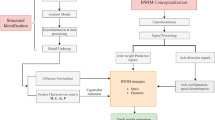Abstract
Weigh-in-motion (WIM) systems aim at dynamic weighing of the railway vehicles through a reasonable number of measurement stations placed along the track. Such systems may overcome disadvantages in terms of costs and traffic management typical of conventional static weighing systems. In the present work the authors present an innovative algorithm for high speed dynamical WIM applications aimed at the estimation of axle or wheel loads of a generic train composition by means of indirect track measurements. The formulation of the proposed algorithm is quite general and it can be customized for several track measurements (rail shear, rail bending, vertical forces on the sleepers etc.) as well as a combination of them; consequently it can be employed in different kinds of measurement stations. The vertical loads and the possible imbalances are estimated by supposing the system approximately linear with respect to the loads and by means of least square minimization techniques. A wide simulation campaign has been carried out to test the algorithm accuracy and robustness under any operating conditions, obtaining good results (estimation errors always below the 2 %). Future developments of the present work will include the algorithm validation by means of some dedicated experimental campaigns performed by Ansaldo STS and ECM SpA, the industrial partners of this research project.























Similar content being viewed by others
References
Molodova M, Li Z (2011) Axle box acceleration: measurement and simulation for detection of short track defects. Wear 271:349–356
Molodova M, Li Z, Nunez A, Dollevoet R (2014) Automatic detection of squats in railway infrastructure. IEEE Trans Intell Transp Syst 15(5):1980–1990
Mayer R, Poulikakos L, Less A, Heutschi K, Kalivoda M, Soltic P (2012) Reducing the environmental impact of road and rail vehicles. Environ Impact Assess Rev 32(1):25–32
Poulikakos L, Arraigada M, Morgam G, Heutschi K, Anderedd P, Partl M, Soltic P (2008) In situ measurements of the environmental footprint of freight vehicles in Switzerland. Reducing Environ Impact Road Rail Veh 13(4):274–282
Bracciali A, Ciuffi R, Piccioli F, Knothe K (2001) Progetto e validazione di un sensore estensimetrico multifunzionale per il binario ferroviario. In: Proceedings of XXX congresso AIAS, Alghero, Italy
http://www.tagmaster.com. Official site of Stock Equipment Company (2012)
Kolakowski P, Sekula K (2010) Piezo-based weigh-in-motion system for the railway transport. Struct Control Health Monit. doi:10.1002/stc.416
http://www.stockequipment.com. Official site of Stock Equipment Company (2012)
http://www.cardinalscale.com. Official site of Cardinal (2012)
Prete C, Rosso C (2009) An easy instrument and a methodology for the monitoring and the diagnosis of a rail. Mech Syst Signal Process 23(3):940–956
http://www.kistler.com. Official site of Kistler (2011)
Iwnicki S (2006) Handbook of railway vehicle dynamics. Taylor and Francis, Oxfordshire
Kisilowski J, Knothe K (1991) Advanced railway vehicle-system dynamics. Wydawnictwa Naukowo-Techniczne, Warsaw
Sekula K, Kolakowski P (2010) Identification of dynamic loads generated by trains in motion using piezoelectric sensors. In: Proceedings of ISMA
Meli E, Pugi L (2013) Preliminary development, simulation and validation of a weigh in motion system for railway vehicles. Meccanica 48(10):2541–2565
Rindi A, Pugi L, Meli E (2014) An innovative high speed weigh in motion system for railway vehicles. Mechatronic and embedded systems and applications (MESA), Senigallia, Italy
Kelley CT (1995) Iterative methods for linear and nonlinear equations. Frontiers in applied mathematics, vol 16. SIAM, Philadelphia
Shampine L, Reichelt M (1997) The matlab ODE suite. SIAM J Sci Comput 18:1–22
Nocedal J, Wright S (1999) Numerical optimization. Springer, Springer Series in Operation Research
Meli E, Falomi S, Malvezzi M (2011) Multibody modeling of railway vehicles: innovative algorithms for the detection of wheel-rail contact points. Wear 271(1–2):453–461
Meli E, Falomi S, Malvezzi M, Rindi A (2008) Determination of wheel–rail contact points with semianalytic methods. Multibody Syst Dyn 20(4):327–358
http://www.comsol.com. Official site of Comsol Multiphysics (2012)
http://www.mathworks.com. Official site of The MathWorks (2012)
Kalker J (1990) Three-dimensional elastic bodies in rolling contact. Kluwer, Dordrecht
Dahlberg T (2001) Some railroad settlement models—a critical review. J Rail Rapid Transit 2015:289–300
Zakeri J, Xia H, Fan J (2009) Dynamic responses of train-track system to single rail irregularity. Lat Am J Solids Struct 6:2
Dahlberg T (2002) Railway track settlements—a literature review and a Bibliography. Report for the EU project SUPERTRACK, Solid Mechanics, IKP, Linköping University, Linköping, Sweden, 41 pp
Iwnicki S (2008) The Manchester benchmarks for rail vehicle simulators. Swets and Zeitlinger
Rindi A, Pugi L, Meli E (2012) Weighing in motion of railway vehicles: development and comparison of different identification/measurement techniques. European congress on computational methods in applied sciences and engineering (ECCOMAS), Vienna, Austria
Oregui M, Li Z, Dollevoet R (2015) An investigation into the modeling of railway fastening. Int J Mech Sci 92:1–11
Oregui M, Li Z, Dollevoet R (2015) Identification of characteristic frequencies of damaged railway tracks using field hammer test measurements. Mech Syst Signal Process 54–55:224–242
Author information
Authors and Affiliations
Corresponding author
Rights and permissions
About this article
Cite this article
D’Adamio, P., Marini, L., Meli, E. et al. Development of a dynamical weigh in motion system for railway applications. Meccanica 51, 2509–2533 (2016). https://doi.org/10.1007/s11012-016-0378-2
Received:
Accepted:
Published:
Issue Date:
DOI: https://doi.org/10.1007/s11012-016-0378-2




